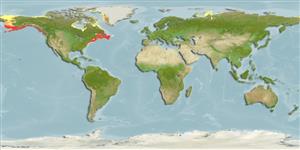Echinoidea |
Echinolampadacea |
Echinarachniidae
Environment: milieu / climate zone / djupintervall / distribution range
Ekologi
; djupintervall 0 - 150 m (Ref. 95072). Polar
Arctic, Northern Pacific and Northern Atlantic. Polar to subtropical.
Length at first maturity / Size / Weight / Age
Könsmognad: Lm ? range ? - ? cm
Life cycle and mating behavior
Könsmognad | Reproduktion | Lek | Eggs | Fecundity | Larvae
Members of the class Echinoidea are gonochoric. Fertilization is external. Brooding is common, eggs are held either on the peristome, around the periproct or deep into the concavities on the petaloids. Life cycle: Embryos develop into planktotrophic larvae (echinoplateus) and live for several months before they sink to the bottom using their tube feet to adhere on the ground where they metamorphose into young urchins.
Austin, W.C. 1999 Rare and endangered marine invertebrates in British Columbia. Proc. Biology and Management of Species and Habitats at Risk, Kamloops, B. C., 15-19, Feb 1999. (Ref. 1306)
IUCN Red List Status
(Ref. 130435: Version 2025-1)
CITES status (Ref. 108899)
Not Evaluated
Not Evaluated
Threat to humans
Human uses
| FishSource |
Verktyg
Ytterligare information
Trophic EcologyFood items (preys)FödosammansättningFödointagPredatorer Population dynamicsTillväxtMax. ages / sizesLength-weight rel.Length-length rel.Length-frequenciesMass conversionAbundans PhysiologySyreförbrukning
Human RelatedStamps, coins, misc.
Internet-källor
Estimates based on models
Preferred temperature
(Ref.
115969): 1.5 - 11.5, mean 5.4 (based on 800 cells).
Price category
Unknown.
